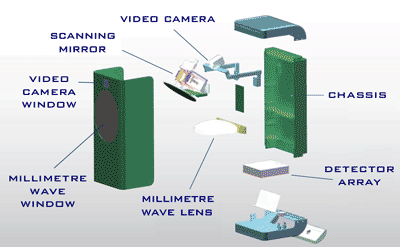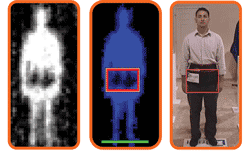
home | Who are we? | Workshop | Resources | Links | Gallery |
| Brijot Scanner |
This millimetre wave camera uses a nodding mirror to build up an image from a line of detectors. With fewer pixels to collect, millimetre wave moving images can be recorded in real time and the system operates at walk-through speeds to minimise passenger inconvenience at airports etc.
Here you can see how the threat object shows up as a dark region on the torso, blocking the body heat. the computer recognises this (blue man) and places an alarm box on top of the video image the alarm can be raised without a human operator ‘looking through’ clothing Brijot Imaging Systems |
'Vision For The Future' is an EPSRC funded project run by the MMW group at the University of St Andrews
Copyright ©2006 by the University of St Andrews :: web, graphic and exhibition design by FifeX Ltd, www.fifex.co.uk
 A
practical security system has to be small which means that the millimetre
wave images have relatively low resolution. However, this has advantages:
the millimetre wave pictures do not reveal the body in any private
detail.
A
practical security system has to be small which means that the millimetre
wave images have relatively low resolution. However, this has advantages:
the millimetre wave pictures do not reveal the body in any private
detail. Thus one way to deal with privacy concerns is to use a computer rather
than a person to analyse the images, and give an alarm if a suspicious
object is being carried
Thus one way to deal with privacy concerns is to use a computer rather
than a person to analyse the images, and give an alarm if a suspicious
object is being carried